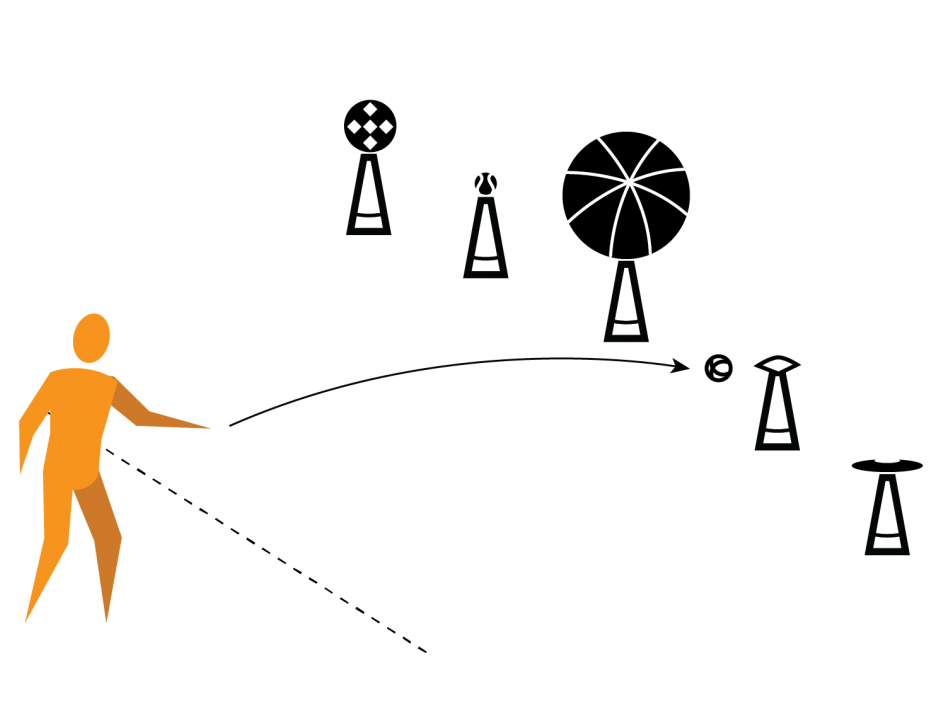TGfU Category: Target Games
Locations: gymnasium, outdoor space (e.g., field, tarmac)
Game/Sport Connections
Target games are activities in which players send an object toward a target while avoiding any obstacles. By playing these games, participants develop skills and tactics to play other target games or games that require the application of similar skills, concepts, and strategies (e.g., archery, bocce, bowling, croquet, curling, golf, horseshoes, shuffleboard, Snow Snake).
Activity Overview
Participants learn about and practise sending an object to hit a target to score points.
Key Movement Skills, Concepts, and Strategies
Throughout the activity, consider highlighting the following skills, concepts, and strategies for effectively sending an object toward a target. Note that this list is not exhaustive and further learning opportunities may arise during the task.
Movement Skills and Concepts
Manipulation skills and effort awareness: applying a controlled force to send the object toward the target.
Movement Strategies
Applying appropriate strategies and tactics to be proficient at knocking down the target (e.g., using an appropriate amount of force depending on the type of object being sent and the size and weight of the target).
Considerations
- Incorporate some or all of the variations listed in the “Variations” section while planning the activity. This will help to best meet the diverse backgrounds, identities, needs, and interests of participants and maximize the fun, inclusion, participation, and success of everyone.
- To elevate participant voice and choice, periodically pause the activity and share the variations with participants. Ask them to determine how they would like to change the activity to maximize the fun, inclusion, meaningful participation, and success for everyone. Encourage participants to add any variations of their own.
Equipment
- 1 score card per participant (optional)
- 3 objects to send per group (e.g., rubber chickens, soft-skinned balls, beanbags, foam relay batons, soccer balls, foam footballs, balls with a tail)
- 5 different objects of various sizes per group to use as targets (e.g., beach balls, discs, tennis balls, soccer balls, beanbags)
- 6 pylons per group
Safety
- Inspect the equipment and activity area to identify and remove hazards. Check that the activity surface provides sufficient traction.
- Establish the boundaries for the designated playing area at a safe distance from walls and obstacles. Share the boundaries with participants.
- Review the safety rules and activity instructions with participants prior to the activity.
- Instruct participants to be aware of their surroundings, including the locations of other participants during play.
How to Play
- Divide participants into pairs or small groups (e.g., 3 – 4). This activity can also be set up for parallel play.
- Participants set up their area, placing 5 pylons approximately 1 m apart in a horizontal line.
- Participants select a designated spot to send from that is a challenging distance from the pylons and mark it with another pylon. Participants may increase or decrease the distance at any point during play, being mindful of other participants’ designated playing areas.
- Participants place an object on top of each of the first 5 pylons as a target. Each target is worth a set number of points as decided by the group (e.g., a beach ball is worth 1 point, a soccer ball 2 points, a disc 3 points, a beanbag 4 points, and a tennis ball 5 points).
- Participants select an object to send to hit the target.
- Each participant makes 3 attempts to send an object toward the targets from behind their designated spot. Participants try various ways of sending their object (e.g., underhand/overhand throw, roll, kick while the object maintains contact with the ground, strike out of the hand).
- If a participant knocks the target off the pylon, they earn the number of points that target is worth. Each participant takes turns sending, trying to accumulate as many points as possible during their turn.
- If a target is knocked down, a participant resets it before the next participant’s turn.
- After a period of play, provide participants with some or all of the variations. Ask them to decide how they might change the game to enhance their fun, challenge, and success. Encourage participants to add any variations of their own.
- Consider having groups share their variations and select another variation to try with their group.
Image: Visual Depiction of the Activity Instructions

Pause for Learning
Throughout the activity, ask open-ended questions to help participants refine their movement skills, strategies, and tactical solutions. Examples include:
- How do you choose the targets that you aim at?
- How do you change your effort and/or body movement when sending your object in various ways?
- Which target is the most challenging for you to hit?
- Which games or sports have you played or know about that use similar rules and strategies to the ones used in this game?
Variations
- Use different ways to accumulate points (e.g., place a hula hoop around each target and receive 1 point if the object lands in the hoop and 3 points if the target is knocked down).
- Work as a group so each participant’s points count toward a group total.
- Use the non-dominant hand or foot to send.
- Designate an order for hitting each target or identify the target that needs to be hit (e.g., only knock down each target once, largest to smallest).


